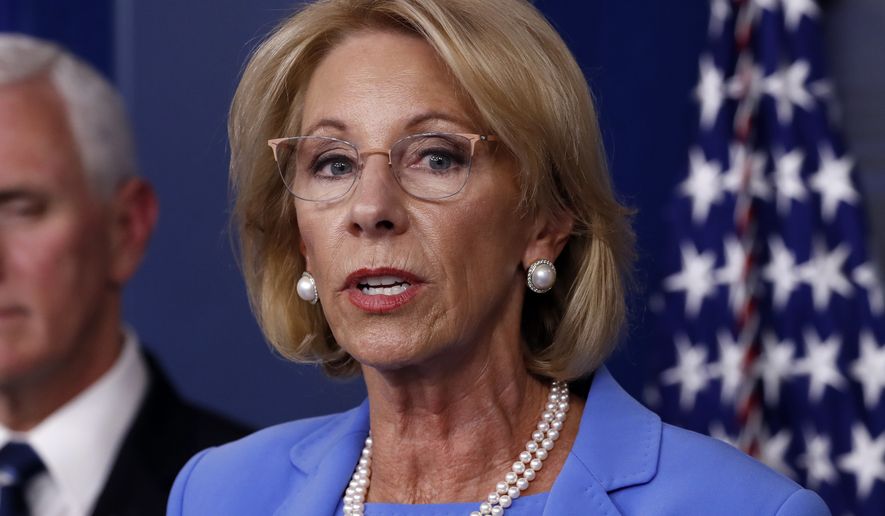Education Secretary Betsy DeVos told reporters Thursday that her department aims to expand and improve remote learning tools and strategies via new funds from the $2.2 trillion economic recovery package passed last month.
“I think it’s very clear that we have an opportunity to embrace distance learning and remote education in a way that two months ago would not have been thought possible,” Mrs. DeVos said. “And it’s happening very well in many places and — out of necessity — many others are getting up to speed.”
The Department of Education has opened a waiver process for various teaching provisions, such as professional development, as more teachers seek to acquire expertise with various technology platforms, from virtual learning programs such as SeeSaw and Schoology to online lectures.
“Most [states] report we’re delivering what they need,” Mrs. DeVos said, noting that 28 states have applied for and received waivers for professional development funding. “America’s teachers want to keep teaching, and America’s students want to keep learning.”
The majority of America’s 56 million schoolchildren are learning at home amid stay-at-home orders in effect in most states because of the coronavirus pandemic. But online learning is not without its glitches.
School districts in Florida, Ohio and Minnesota have reported server crashes on Schoology, a virtual learning platform that lets teachers post assignments and videos to students. It had been used by more than 20 million students and 60,000 schools before the pandemic.
Usage of Schoology reportedly has jumped by 400%. A company spokesman said that there were “performance issues for a short time … due to increased usage” but said the site had quickly returned to functioning normally.
But some students aren’t logging on at all. By late March, Los Angeles officials said only about a third of high school students in the nation’s largest school district had accessed digital classrooms.
In rural Georgia, where high-speed internet remains elusive for 330,000 households, there is a fear that students, especially those in black communities, will be left behind in online learning.
Last month, Georgia Gov. Brian Kemp launched a new website to help the residents find public Wi-Fi spots throughout the state. In some instances, officials directed residents to parking lots outside closed public libraries to connect to the internet.
Schools haven’t been unprepared for this moment, said Michael F. Young, an associate professor of educational technology at the University of Connecticut’s Neag School of Education. But the immediate strain of wholesale migration to digital learning technologies will be felt by districts, he said.
“As schools emphasize distance learning in the immediate circumstances, and consider how to optimize the wise integration of online and virtual learning in the future … the need for both infrastructure and innovative pedagogy will also need to be emphasized,” Mr. Young said in an email. “This seems to be to just accelerate a process of moving toward more online instruction that was already trending in [e]ducation.”
In Wisconsin, Janice Mertes, the assistant director of teaching and learning in the Department of Public Instruction, said teachers have inherited a remote-learning model typically used for keeping students busy during snow days. But the current projection for distance learning will far surpass even the biggest blizzard.
“Really, this situation has highlighted not many teachers really understood what it meant to be an online teacher,” Ms. Mertes said. “Teachers miss their kids … and technology is still that bridge.”
Nevertheless, Wisconsin teachers have sought to use creativity in refashioning classes, from math lessons involving the kitchen to physical education using in-home escape rooms, Ms. Mertes said.
But she acknowledged that some old-school tools are needed as not every student has the same ability to access or make headway of online learning platforms.
“Through the phone you can [always] connect,” Ms. Mertes said.
In the nation’s capital, Mrs. DeVos said professional development funds will aid remote teaching and allow schools or teachers to purchase more technology or “upscale” to deliver remote content during what she called “unchartered territory.”
A department spokesman said that, specifically, federal laws on professional development prohibit “one-day or short-term workshops.” But such training may be necessary to retrain teachers on distance learning platforms and protocols, the spokesman said.
“Schools are obviously in a different posture today than they were a couple of months ago,” said Mrs. DeVos, “[and] the parameters that existing funding had prior to this waiver option meant that many of those funds wouldn’t be accessible for the rest of the school year.”
• Christopher Vondracek can be reached at cvondracek@washingtontimes.com.




Please read our comment policy before commenting.